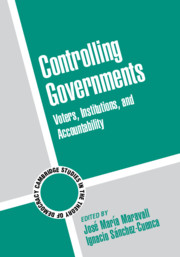Book contents
- Frontmatter
- Contents
- Acknowledgments
- Contributors
- Controlling Governments
- Introduction
- 1 Explaining the Electoral Performance of Incumbents in Democracies
- 2 How Can Governments Be Accountable If Voters Vote Ideologically?
- 3 Enduring Ethnicity: The Political Survival of Incumbent Ethnic Parties in Western Democracies
- 4 Performance or Representation? The Determinants of Voting in Complex Political Contexts
- 5 Political Knowledge and the Logic of Voting: A Comparative Study
- 6 The Political Consequences of Internal Party Democracy
- 7 Choosing Rules for Government: The Institutional Preferences of Early Socialist Parties
- 8 Constitutions and Democratic Breakdowns
- Author Index
- Subject Index
- References
7 - Choosing Rules for Government: The Institutional Preferences of Early Socialist Parties
Published online by Cambridge University Press: 28 October 2009
- Frontmatter
- Contents
- Acknowledgments
- Contributors
- Controlling Governments
- Introduction
- 1 Explaining the Electoral Performance of Incumbents in Democracies
- 2 How Can Governments Be Accountable If Voters Vote Ideologically?
- 3 Enduring Ethnicity: The Political Survival of Incumbent Ethnic Parties in Western Democracies
- 4 Performance or Representation? The Determinants of Voting in Complex Political Contexts
- 5 Political Knowledge and the Logic of Voting: A Comparative Study
- 6 The Political Consequences of Internal Party Democracy
- 7 Choosing Rules for Government: The Institutional Preferences of Early Socialist Parties
- 8 Constitutions and Democratic Breakdowns
- Author Index
- Subject Index
- References
Summary
Introduction
Electoral institutions bear some effect on the control of governments because they influence the manner in which governments can be made vulnerable. Whatever makes office vulnerable for incumbents makes it accessible for nonincumbents. In this chapter, I propose an explanation of the institutional preferences of the most important newcomer group of parties to early democracies, the socialists, in terms of some of the consequences of electoral rules for government formation. I show that what mattered for the parties was not only how many seats could be expected under different institutional arrangements. For socialist parties, electoral rules had a broader impact on their general participation strategy, including their coalition strategy and the link between electoral success and democratic responsibility in policy making. The choice of electoral rules implied a choice between forging their alliances in the electorate – so as to surpass the majoritarian threshold in the constituencies – and obtaining a potentially very variable ability to influence government, including the responsibility of full control as a result of elections, or forging their alliances in parliament, under proportional rule, and holding a relatively constant but more restrained influence on government. It was the parties more firmly rooted in the working class, understood in terms of unionized voters, those who were more willing to commit themselves to an institutional strategy that entailed not only a broader electoral appeal but also a more steadfast, and risky, participation in democratic government.
- Type
- Chapter
- Information
- Controlling GovernmentsVoters, Institutions, and Accountability, pp. 202 - 246Publisher: Cambridge University PressPrint publication year: 2007
References
- 3
- Cited by



